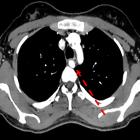Dysphagia lusoria
















Dysphagia lusoria is an impairment of swallowing due to compression from an aberrant right subclavian artery (arteria lusoria).
Clinical presentation
Most patients with aberrant right subclavian arteries do not have symptoms. Some present with mild dysphagia, while a small minority have a severe enough disturbance in swallowing that leads to inability to swallow and severe nutritional problems.
In children, the most common presentations are stridor and recurrent chest infections, may be due to their tracheal softening comparing to adult population.
The diagnosis of dysphagia lusoria is always difficult and late as the symptoms are often nonspecific and in the same time, diagnostic endoscopy is negative in more than 50% cases, and manometry has no diagnostic role.
Compression of the esophagus by the aberrant right subclavian artery can be exacerbated by atherosclerosis or aneurysmal dilatation.
Radiographic features
Plain radiograph
Chest radiographs can demonstrate enlargement of the superior mediastinum.
Fluoroscopy
Barium study of the esophagus may show the indentation on the posterior esophageal wall by the artery.
CT/MRI
CT angiography and MRI thorax are the best diagnostic modalities that could identify the arteria lusoria.
History and etymology
The word lusoria comes from the Latin phrase lusus naturae, meaning "freak of nature", which refers to the anomalous course of the artery .
Differential diagnosis
As adult-onset of dysphagia lusoria is rare, it should prompt evaluation for other reasons such as malignancy, vascular disease, or gastro-esophageal reflux disease .
Siehe auch:

 Assoziationen und Differentialdiagnosen zu Dysphagia lusoria:
Assoziationen und Differentialdiagnosen zu Dysphagia lusoria:

